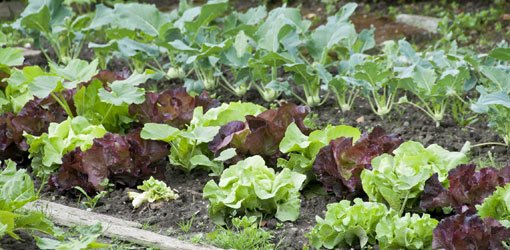How To Store Serenade Garden Diseas Control?

Vegetable gardens are full of life, and some of the many critters that live there like to use your garden as a buffet, which can damage and sicken plants. The most likely garden pests are aphids, slugs and snails, and caterpillars.
Aphids
Aphids are very small, soft-bodied insects that suck sap out of plant leaves, causing leaves to become limp, yellowed, and curled. In large numbers aphids can even stunt plant growth.
There are many sub-species of aphids, and each may favor a certain type of plant over others; but there are enough aphid types to affect almost all plants. In vegetable gardens, aphids can target beans, cabbage, melons, cucumbers, peas, potatoes, pumpkin, squash, and tomatoes.
Tips to identify and treat aphid infestations:
-
- Aphids are only 1/8" long and are usually a very pale color, so finding them can be difficult. Check the underside of leaves, and plants that appear sickly. Large populations of ants can sometimes indicate an aphid problem, since ants feed on the "honeydew" substance secreted by aphids.

-
- Prune and discard heavily infested leaves or branches. If some plants are extremely infested with aphids, consider removing the entire plant in order to reduce the population.
-
- To control aphids without chemicals, spray plants with a strong stream of water from a hose to knock aphids off the leaves, since they can have a hard time getting back onto the plant again.
-
- Encourage ladybugs and lacewings to frequent your garden, since they are natural predators of aphids.
- Insecticidal soaps and some horticultural oils (like neem oil) have been shown to be very effective on aphids, and many formulations can be used in organic gardens.
Find out more in our article on How to Control Aphids.
Slugs and Snails
It can be difficult to determine whether snails and slugs are responsible for damage in the garden since they're nocturnal feeders and hide out in moist, shady areas during the day. Slugs and snails feed on both living and dead organic matter, making leaves, roots, low hanging fruits, and stems all in danger of becoming snail food. Strawberries, cabbages, and hostas are especially vulnerable to snail and slug damage.
Tips to identify and treat snail and slug infestations:
-
- The easiest way to cut down on snail and slug populations is to remove them by hand. Once you've identified these critters as the culprits of your plant damage, go out at night to catch them in the act and drop them in a bucket of soapy water.

-
- Check under leaves, boards, rocks, lawn furniture, or anywhere that has a shady, moist environment.
-
- Try to reduce excess moisture in your garden or lawn.
-
- Remove dead plant matter from your garden, like weed or leaf piles and dead plants, as these serve as both shelter and a food source for slugs and snails.
-
- There are many products available that work to kill slugs and snails by dehydration, and some products also contain a bait component to attract them. Most products are made with all natural ingredients, making them safe to use around non-target animals and insects. Apply these products after a rain or watering, since this is when snails and slugs are most active.
-
- Avoid using salt, as this will not only kill slugs, but also raise the salinity of your soil and possibly kill plants as well.
- Traps (like shallow dishes of liquid) and barriers of copper flashing are also commonly used. Copper is believed to irritate snails and slugs by reacting with their natural secretions.
Find out more in our article on How To Control Slugs and Snails.
Caterpillars
While many species of caterpillars are mostly harmless, some immature moths can cause heavy damage to garden plants. They can descend in large groups to ravage certain plants overnight, while in other cases there might only be a handful of damaging worms throughout your garden.
Visible damage can include ragged holes in leaves, eaten fruit (like tomatoes), and cut off seedlings and tender shoots. Common damaging caterpillars include: Cutworms, cabbage looper, imported cabbage worms, cross striped cabbage worms, diamondback moth caterpillars, tomato hornworms, fall webworms, and armyworms.
Tips to identify and treat caterpillar infestations:
-
- How you control caterpillars depends on the kind and extent of damage and how many are active. If there are only a few here and there, handpicking can be sufficient to control damage.

-
- Cardboard or aluminum collars can prevent some caterpillars (like cutworms) from chewing stalks or stems. However, other caterpillars can climb very high, so these measures will not prevent damage for all types.
- If caterpillars are numerous and your plants are suffering, you may have to use vegetable garden pest control products to control them. Make sure you choose products that are safe to use on vegetables—like neem oil, spinosad, or baccilus thuringiensis. Pyrethrin, carbaryl, and cyfuthrin are also products shown to be successful at controlling caterpillars; but be careful when using them around vegetables and non-target animals.
Find out more in our article on Caterpillars in the Garden.
About the Author
Jenny Gagas is a home and garden writer living in Wisconsin who loves to spend as much time outdoors as possible. She mostly writes about gardening, and really enjoys teaching people how to interact with their surroundings in a safe and sustainable way. If she's not outside, she's in the kitchen, developing recipes to share with family and friends.
How To Store Serenade Garden Diseas Control?
Source: https://todayshomeowner.com/how-to-control-three-common-vegetable-garden-pests/
Posted by: brittpreal1963.blogspot.com

0 Response to "How To Store Serenade Garden Diseas Control?"
Post a Comment